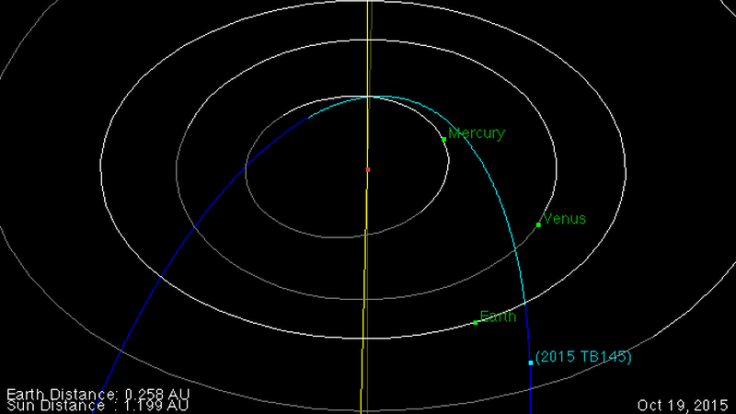Halloween Asteroid 2015 TB145 Hurtling Toward Earth At 80,000 MPH: Doomsday Threat?

Here's something space-y and spooky for Halloween: An asteroid measuring up to 620 meters (2,034 feet) in diameter is making its incredibly fast close approach past Earth on Oct. 31. Asteroid 2015 TB145, discovered on Oct. 10, will be the largest object to make its close approach to Earth until August 2027. Since discovering it just 10 days ago, NASA's asteroid monitoring has been projecting its trajectory.
NASA's Near-Earth Object Program is usually really good at identifying asteroids when they're further away, but asteroid 2015 TB145's highly eccentric orbit delayed the discovery. The Pan-STARRS 1 telescope in Hawaii was responsible for its discovery. Because of its fast speed, expected to be around 78,830 mph during the close approach, large size and distance -- just 1.3 lunar distances (around 310,188 miles) -- there was some concern the asteroid would pose a threat to Earth, but it's mostly an exciting scientific opportunity.
The asteroid is an unusual one, but it's being carefully monitored. Dr. Lance Benner, from NASA's Jet Propulsion Lab, wrote the description for asteroid 2015 TB145 as part of Goldstone Solar System Radar scheduled observations. "The flyby presents a truly outstanding scientific opportunity to study the physical properties of this object. The encounter velocity is 35 km/s, which is unusually high. This is the closest approach by a known object this large until 1999 AN10 approaches within 1 lunar distance in August 2027," Dr. Benner wrote.
Asteroid 2015 TB145 is not the only asteroid making its close approach in October, but it will be the closest to Earth. There are always new reports of a "doomsday asteroid" -- like September's nonexistent asteroid -- but so far NASA has not found a NEO that would pose a threat to humanity (there's no real defense system). NASA recently announced a partnership with the National Nuclear Security Administration to plan a planetary defense system, according to the New York Times.
© Copyright IBTimes 2024. All rights reserved.






















